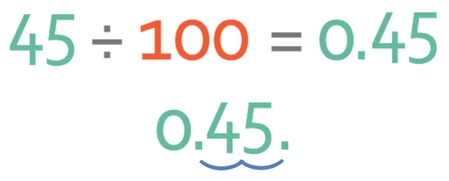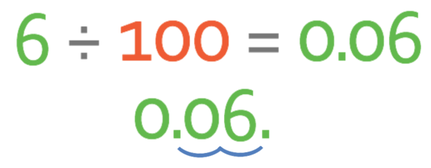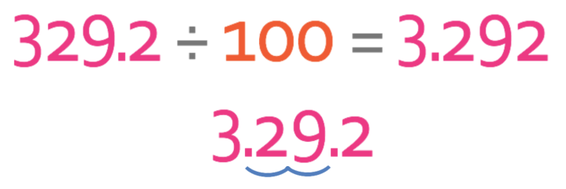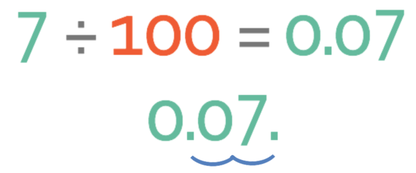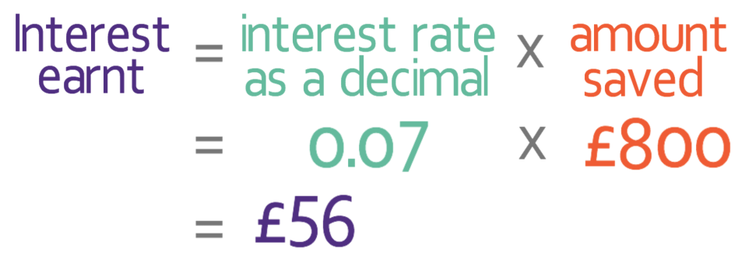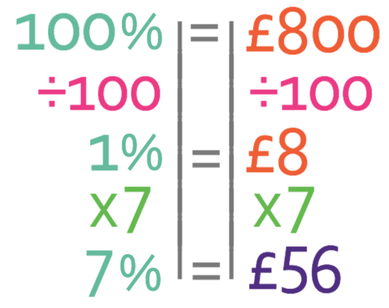Back to AQA Percentages (F) Home
3.2 E) Converting Percentages into Decimals
3.2 E) Converting Percentages into Decimals
We are easily able to convert percentages into decimals by dividing by 100. This is because percentage is defined as per 100.
Example 1
Convert 45% into a decimal.
We convert 45% into a decimal by dividing by 100.
Convert 45% into a decimal.
We convert 45% into a decimal by dividing by 100.
When we are dividing by 100, we move the decimal place two places to the left.
Therefore, 45% as a decimal is 0.45.
Example 2
What is 6% as a decimal?
We divide by 100 to convert a percentage into a decimal and this gives us an answer of 0.06.
What is 6% as a decimal?
We divide by 100 to convert a percentage into a decimal and this gives us an answer of 0.06.
Example 3
Let’s have an example that has a non-integer percentage. What is 94.56% as a decimal?
Like before, we divide 94.56 by 100 and this gives us 0.9456 as our answer.
Let’s have an example that has a non-integer percentage. What is 94.56% as a decimal?
Like before, we divide 94.56 by 100 and this gives us 0.9456 as our answer.
Example 4
What is 329.2% as a decimal? We obtain our answer by dividing by 100 and this gives us a value of 3.292.
What is 329.2% as a decimal? We obtain our answer by dividing by 100 and this gives us a value of 3.292.
A (positive) percentages that is less than 100% is going to give you an answer that is 0.something. A percentage that is greater than 100% will give you an answer that is greater than 1.
Why is it Useful to Use Decimals?
Having decimals rather than percentages is very useful especially when we are looking at interest earnt on saving and interest paid on borrowing/ loans. Let’s have an example where using a decimal is useful.
Having decimals rather than percentages is very useful especially when we are looking at interest earnt on saving and interest paid on borrowing/ loans. Let’s have an example where using a decimal is useful.
Example 5
I have placed £800 into a bank account that has an interest rate of 7% per year. I leave my money in the bank account for 1 year. What is the amount of interest that I earn on my savings?
The first stage to answer this question is to convert 7% into a decimal, which we do by dividing by 100, which gives us 0.07.
I have placed £800 into a bank account that has an interest rate of 7% per year. I leave my money in the bank account for 1 year. What is the amount of interest that I earn on my savings?
The first stage to answer this question is to convert 7% into a decimal, which we do by dividing by 100, which gives us 0.07.
We now multiply the interest rate as a decimal (0.07) by the amount of money that I saved (£800).
The interest that I earnt from saving £800 for one year was £56.
We could have also found the answer by dividing 800 by 100 to give us the value of 1% and then multiplying by 7 because we want to know what 7% of the amount is rather than 1%. When we do this, we get the following working.
We could have also found the answer by dividing 800 by 100 to give us the value of 1% and then multiplying by 7 because we want to know what 7% of the amount is rather than 1%. When we do this, we get the following working.
At the moment, you may think that using decimals rather than percentages is a bit pointless, but we will see later in this section that using decimals rather than percentages is very useful especially when we are dealing with compound interest.


